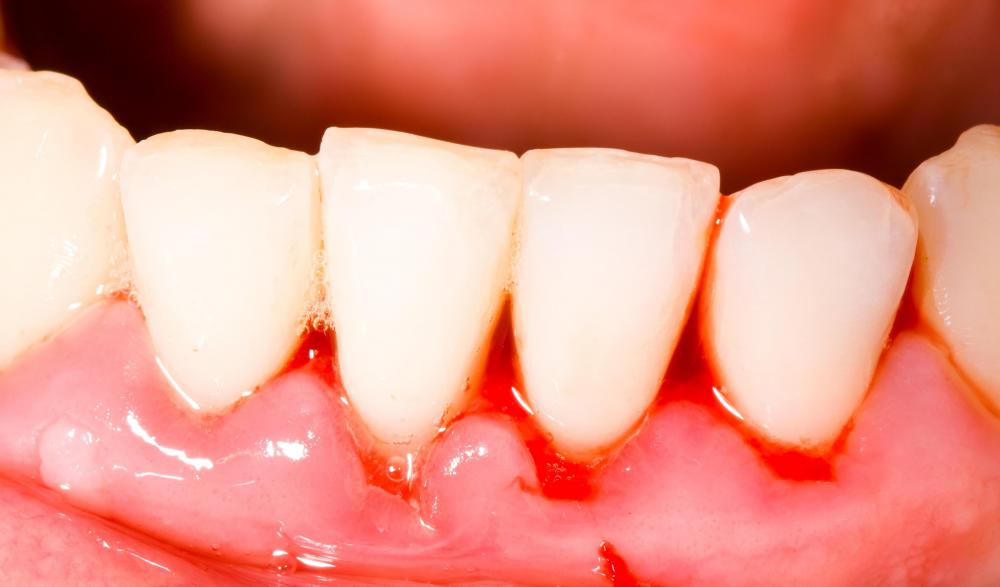At WiseGEEK, we're committed to delivering accurate, trustworthy information. Our expert-authored content is rigorously fact-checked and sourced from credible authorities. Discover how we uphold the highest standards in providing you with reliable knowledge.
What are the Best Tips for Reversing Gingivitis?
Millions of people have gingivitis and are not even aware of it, believing that bleeding gums are normal when brushing. Reversing gingivitis after it has thrived for a long time is likely best done with the help of a dentist, but minor gingivitis cases can sometimes be reversed at home with some know-how and persistence. It is important to brush at least twice daily, being careful to brush longer rather than harder. Flossing at least once per day is also a necessary step of reversing gingivitis. Lastly, if the affected person is using a medium or hard toothbrush or a brush of unknown bristle stiffness, he or she might benefit from switching to a soft toothbrush.
Dental associations around the world are convinced that people need to brush at least twice daily to have a healthy mouth. Still, some studies show that a significant portion of the population neglects to do so, even if they have the resources and time. When brushing the teeth, the brusher should aim to brush longer instead of harder. Brushing hard to eliminate plaque can irritate the gums and damage the enamel of the teeth. To brush for the appropriate amount of time, the brusher can count to a certain number or hum a song that is about two minutes long.

Next, reversing gingivitis might be easier with a toothbrush less likely to cause gum and tooth damage. Many dental associations advise against using brushes other than those labeled soft. Medium to hard toothbrushes can cause damage to gums and teeth, all while not doing a much better job of removing plaque than soft toothbrushes.
Flossing on a daily basis is normally considered a requirement of reversing gingivitis because it helps achieve and maintain healthy gums and teeth. While tooth brushing is important, flossing takes care of the teeth and gums in a slightly different way. It removes food particles and dental plaque around the gum line, a place a toothbrush usually cannot reach.

Visiting a dentist can be an important component of reversing gingivitis. In addition to helping maintain oral health through cleaning the teeth and gums, a dentist can provide advice on methods to prevent gingivitis. It is not typically advised that a person with gingivitis try to reverse it by themselves, and doing so can be dangerous or ineffective. Severe gingivitis may be nearly impossible to reverse without the consistent aid of a qualified oral health professional.
AS FEATURED ON:
AS FEATURED ON:
















Discussion Comments
@jennythelib - I went through something similar. My husband and I both needed treatment for gingivitis after we went a couple of years without seeing a dentist. (We had moved a couple of times, didn't have dental insurance, etc.)
I've always used regular floss and just had to adjust my technique. My husband hadn't been flossing at all because he couldn't reach between his teeth. The hygienist said that a lot of men have that problem because of their thick fingers. Some are happy with those disposable flossers, but my husband like the Reach Access.
They sell it with the floss - it looks a little like a toothbrush handle with a flosser head instead of a toothbrush head. The handle is reusable and you have to buy new flosser heads. It is the most expensive option; floss is the cheapest, and disposable flossers are next. But it is much cheaper than gum disease! Definitely worth it.
When I had a mild case of gingivitis, I was told that the first thing with treating gingivitis is to either start flossing or start flossing *correctly.* A lot of people think they've done their job if they just snap the floss between their teeth. Not so! You have to get the floss under the gumline.
The hygienist taught me to move the floss upwards three times for each side of the space - you have to get under the gum next to each tooth, not just get in between the teeth.
People think of the goal of flossing as removing food caught between the teeth. It certainly can do that, but more importantly, it pulls bacteria from under the gums. The 1-2 punch, as my dentist called it, is to floss and then use an antiseptic mouthwash.
Post your comments